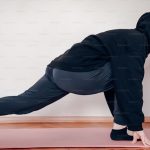Our wrists are truly amazing pieces of bioengineering. Yet we rarely pay them much attention – that is until they hurt. Then we worry that we will have to stop doing those delicious hand weight-bearing poses that love. But with a little care and attention our wrists can be content in cobra (bhujangasana): thoroughly dependable in down dog (adho muka svanasana) and wholly happy in handstands (adho mukha vrksasana). Here’s how:
Anatomy
The actual wrist joint is where the radius and ulna join with the first 3 bones of the carpus (the scaphoid, lunate and triquetrum). There is a triangular fibrocartilage structure (TFC) on the little finger side of the wrist between
the triquetrum and ulna. This helps to absorb compression in the wrist joint and stabilises it in some positions.
The wrist can flex and extend (bend up and down) as well as moving side to side (radial and ulna deviation). Turning the palm up and down (supination and pronation) happens at the radioulnar joints as the radius moves around the ulna. It is this ability to pronate the forearm that allows us to place our hands palm down on the floor to weight bear through our arms.
Most of the muscles controlling wrist movements come from the elbow and some go as far as the fingertips. These are muscles in the forearm but become tendons by the time they reach the wrist. The tendons are held in place by fibrous structures called retinaculi at the front and back of the wrist. These hold the tendons firmly against the wrist bones and makes the muscles more effective when we grip.
There are also 3 nerves that pass over the wrist – the median and ulnar on the palm side and the radial on the thumb side of the back.
Common Problems
Despite their complex structure, wrists are incredibly robust and generally present us with few problems. The most common are:
- TFCC injury – sometimes the fibrocartilage pad on the little finger side of the wrist can get damaged. Symptoms are pain in the wrist on weight bearing and whilst rotating the wrist.
- Carpal Tunnel Syndrome – this is where the median nerve gets compressed as it passes under the flexor retinaculum on the palm side of the wrist. The main symptoms are tingling or numbness in the thumb, index, middle and half of the ring finger.
Though not a ‘medical problem’ it is really common for inexperienced yogi’s to feel wrist pain in poses like down dog. This is because their weight ‘dumps’ into the wrist rather than spreading further forward into the knuckles and fingers. Ultimately this could lead to medical problems. But the good news is that it is really easily addressed with attention to good technique and a bit of groundwork in our practice.
Prevention is Better than Cure
Wrist care is vital at all levels of practice but particularly so if you are a novice yogi or work with beginners. Developing good technique in arm weight-bearing as soon as possible is a foundation stone of practice – literally and figuratively!
Here are my top tips for happy, healthy wrists.
-
- Strong shoulder girdle – strengthening the shoulder girdle muscles, especially serratus anterior and rhomboids, holds the upper body firmly supported on the trunk and allows the wrists to lift a little when loaded. This, in turn, reduces pressure through the wrist. Try working on hands and knees to push the floor away as you lift the knees a fraction – I call this knee hovers – hold for a few seconds and repeat a few times during your practice.
- Strong core – a bit like the shoulder girdle, weakness in a yogi’s core makes overloading the wrists worse. Regressing core work to build strength with good form will quickly reap rewards. Try side planks on knees and elbows, plank on knees, and knees down when lowering through chaturanga dandasana. Only progress on to full expressions of these poses when the form is perfect.
- Strong wrist flexors – strengthening the muscles that bend the fingers into a fist allows a micro-lift of the wrist in arm weight-bearing poses. A great way to do this is to hold down dog or plank on finger and thumb tips (‘cupcake’ hands) for a few seconds. Really strong yogi’s can do whole sun salutes like this but that is nails!
- Light wrists – in down dog, focus on pressing through fingertips and knuckles while feeling ‘light’ under the wrists. Placing a small rolled towel under the wrists will give the feel of taking that loading forwards into the fingers. This can be really useful when you are trying to work out where the pressure should be. As you get stronger, use pressure through the fingers to push your weight back into your heels in down dog.
- Alignment – we are all different. For some people, ideal alignment of the wrist in weight bearing will be with the index finger pointing forwards. For others, it will be the middle finger parallel with the side of the mat. Best way to find out which is for you? Play around. Look at your wrist crease in kneeling on hands and knees. Great alignment is when the crease is an even depth from inside to outside. If it is deeper in some places and shallower elsewhere, move around until it is even. That is perfect alignment for YOU.
For the Yogi with Wrist Pain
If you are unfortunate enough to already have wrist, or hand pain, you may find it useful to modify poses to take the weight away from those areas. Try using your forearms for planks and down dog. Supported headstands will be more comfortable than tripod ones and standing sun salutes could replace traditional ones. Loading through clenched fists with straight wrists works for some people in arm weight bearing poses too.
As well as these modifications, strengthening, your shoulder girdle and core may help to make flat hand weight bearing more comfortable in the future. Core work that does not load the wrist includes:
- Navasana (boat) pose – one of those poses that we love to hate, but fab for core strength.
- Virabhadrasana (warrior) 3 – holding the body straight as you fold forwards engages the core beautifully.
- Trikonasana (triangle) – lifting up out of this pose without the help of your hands uses the core – try it with both hands overhead for a REAL core challenge.
- Setu Bandha Sarvangasana (bridge) – focus on engaging the abs as you lift the hips to activate the core.
The Last Word
Wrist pain is not a barrier to yoga nor should it be part of the journey. Be kind to yourself and give time for the necessary strength to build throughout the body before expecting your wrists to support you in arm weight bearing. With patience and care they will willingly let you fly in countless bakasana (crow) poses. Love your wrists and they will love you back.













